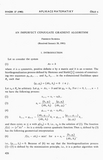Article
Full entry |
 PDF
(0.9 MB)
Feedback
PDF
(0.9 MB)
Feedback
 PDF
(0.9 MB)
Feedback
PDF
(0.9 MB)
Feedback
Keywords:
imperfect conjugate gradient algorithm; symmetric, positive definite matrix; biorthogonalization; line searches; global efficiency
imperfect conjugate gradient algorithm; symmetric, positive definite matrix; biorthogonalization; line searches; global efficiency
Summary:
A new biorthogonalization algorithm is defined which does not depend on the step-size used. The algorithm is suggested so as to minimize the total error after $n$ steps if imperfect steps are used. The majority of conjugate gradient algorithms are sensitive to the exactness of the line searches and this phenomenon may destroy the global efficiency of these algorithms.
References:
[1] M. R. Hestenes E. Stiefel: The method of conjugate gradients for solving linear systems. J. Res. Nat. Bur. Standards, 49 (1952), 409-436. DOI 10.6028/jres.049.044 | MR 0060307
[2] R. Fletcher C. M. Reeves: Function minimization by conjugate gradients. Соmр. J., 2 (1964), 149-154. MR 0187375
[3] E. Polak G. Ribiere: Note sur le Convergence des Methods de Directions Conjuges. Reone Fr. Int. Rech. Oper. 16R1 (1969), 35-43. MR 0255025
[4] J. W. Daniel: The conjugate gradient method for linear and nonlinear operator equations. SIAM J. Numer. Anal. 4 (1967), 10-26. DOI 10.1137/0704002 | MR 0217987 | Zbl 0154.40302
[5] L. C. W. Dixon: Conjugate Gradient algorithms: Quadratic termination properties without line searches. J. of Inst. of Math. and Applics, 15 (1975), 9-18. DOI 10.1093/imamat/15.1.9 | MR 0368429
[6] L. Nazareth: A conjugate direction algorithm without line searches. JOTA, 3 (1977), 373 - 387. DOI 10.1007/BF00933447 | MR 0525743 | Zbl 0348.65061
[7] M. J. Best: A Method to Accelerate the Rate of Convergence of a Class of Optimization Algorithms. Math. Programming, 9 (1975) 139-160. DOI 10.1007/BF01681341 | MR 0405840 | Zbl 0352.90053
[8] J. Stoer: On the Relation between Quadratic Termination and Convergence Properties of Minimization Algorithms, Part I. Theory. Num. Math., 28 (1977) 343 - 366. MR 0496670 | Zbl 0366.65027
[9] P. Baptist J. Stoer: On the Relation between Quadratic Termination and Convergence Properties of Minimization Algorithms, Part II, Applications. Num. Math.,28 (1977), 367-391 MR 0496671

